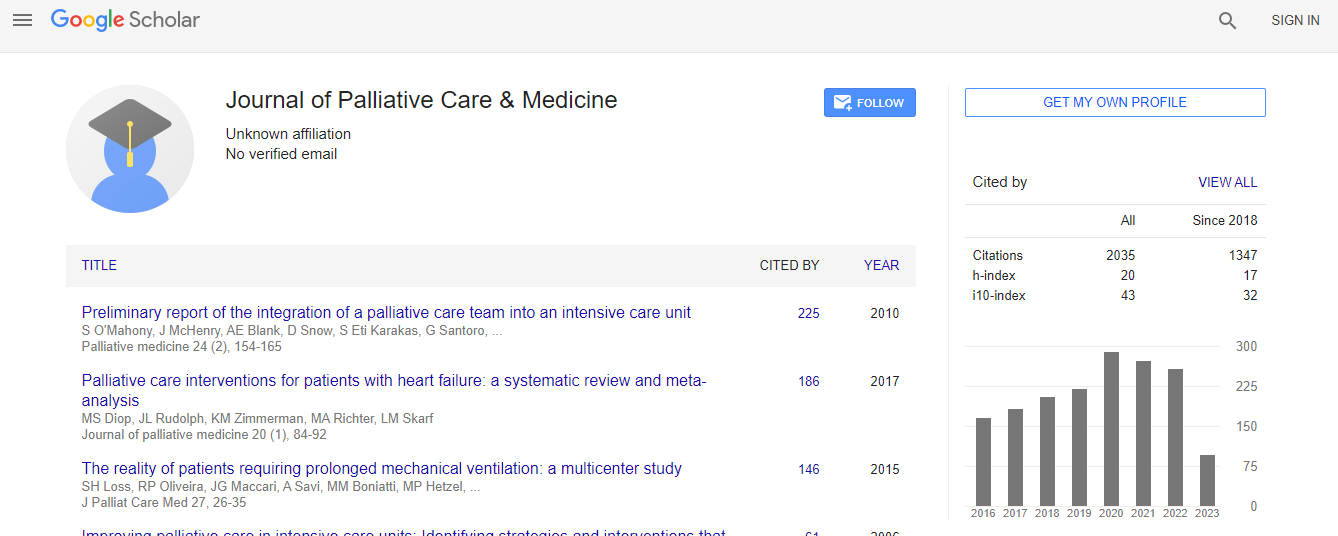Our Group organises 3000+ Global Conferenceseries Events every year across USA, Europe & Asia with support from 1000 more scientific Societies and Publishes 700+ Open Access Journals which contains over 50000 eminent personalities, reputed scientists as editorial board members.
Open Access Journals gaining more Readers and Citations
700 Journals and 15,000,000 Readers Each Journal is getting 25,000+ Readers
Google Scholar citation report
Citations : 1689
Journal of Palliative Care & Medicine received 1689 citations as per Google Scholar report
Journal of Palliative Care & Medicine peer review process verified at publons
Indexed In
- Index Copernicus
- Google Scholar
- Open J Gate
- Genamics JournalSeek
- China National Knowledge Infrastructure (CNKI)
- Electronic Journals Library
- RefSeek
- Hamdard University
- EBSCO A-Z
- OCLC- WorldCat
- Virtual Library of Biology (vifabio)
- Publons
- Geneva Foundation for Medical Education and Research
- Euro Pub
- ICMJE
Useful Links
Recommended Journals
Related Subjects
Share This Page
PATIENT AND SPOUSE PERCEPTIONS OF COGNITIVE AND NEUROPSYCHIATRIC SYMPTOMS IN PARKINSON√ʬ?¬?S DISEASE: IMPLICATIONS FOR DISTRESS, QUALITY OF LIFE AND RELATIONSHIP SATISFACTION
2nd Global Congress on Hospice & Palliative Care
Anna Janssen
Guy√ʬ?¬?s and St Thomas√ʬ?¬? NHS Foundation Trust, UK
Posters & Accepted Abstracts: J Palliat Care Med
Abstract
Introduction: People with Parkinson√ʬ?¬?s Disease (PD) experience a range of Cognitive and Neuropsychiatric Symptoms (CNPS), including depression, fatigue, anxiety, hallucinations and dementia. Patients rate CNPS as among the most important and challenging features of their illness (Politis et al., 2010), yet CNPS is less well understood than motor symptoms. Many loved ones of individuals with PD become informal caregivers. This study investigated the impact of CNPS on carers√ʬ?¬? and patients√ʬ?¬? wellbeing as individuals and on couples√ʬ?¬? relationship satisfaction. Method: This cross-sectional study involved 31 couples living with PD. Clinically valid screening tools and a semi-structured interview assessed the intensity of CNPS and CNPS-related distress. Self-report measures assessed mood, overall distress, health-related quality of life (HRQoL), and relationship satisfaction. Results: Within couples, patients and carers agreed on the levels of total CNPS intensity across the 14 CNPS assessed. Patients and carers within couples disagreed with their views of the presence of specific symptoms, particularly hallucinations, disinhibition, irritability, agitation and aggression, apathy and delusions. Discordance was not associated with distress or relationship satisfaction. Patient overall distress was positively predicted by couples√ʬ?¬? ratings of patient CNPS-related distress. Carer overall distress was positively predicted by carers√ʬ?¬? CNPS-related distress, caregiving-related distress and HRQoL. Carer relationship satisfaction was best predicted by caregiving-related distress. No predictors of patient relationship satisfaction were identified. Discussion: The study demonstrates that relying only patient or carer reports is clinically invalid. Patients√ʬ?¬? and carers√ʬ?¬? distress, experiences of PD-related CNPS, and any discordance within couples must be proactively an accurately assessed and used to inform interventions.Biography
Email: annajanssen23@gmail.com

 Spanish
Spanish  Chinese
Chinese  Russian
Russian  German
German  French
French  Japanese
Japanese  Portuguese
Portuguese  Hindi
Hindi 
